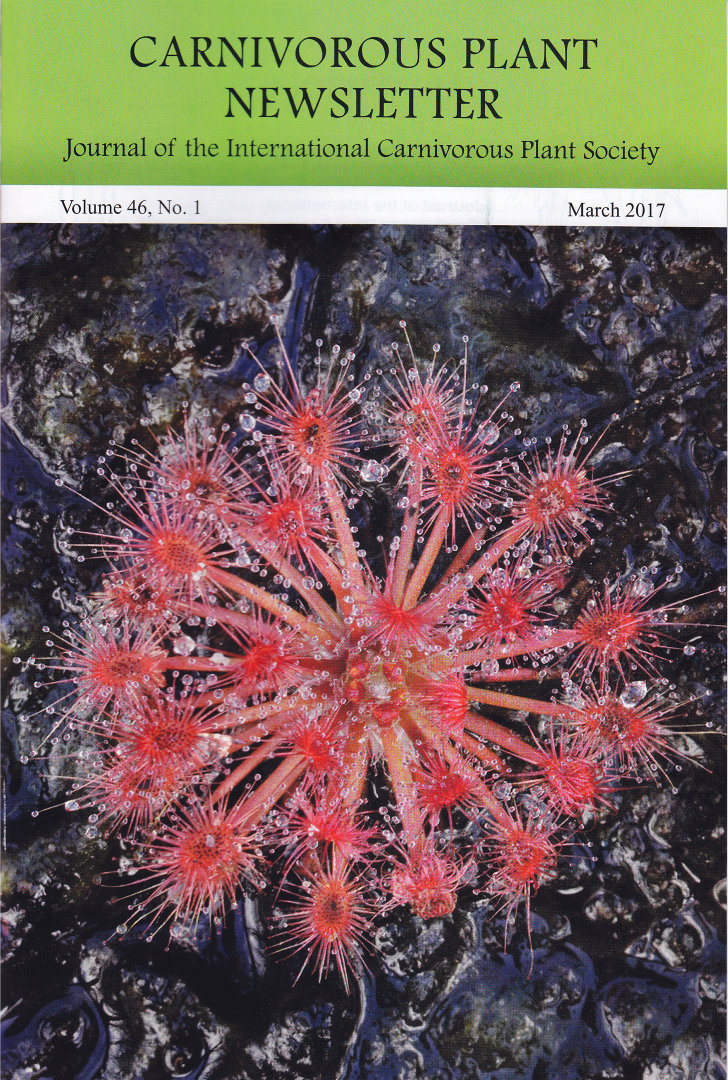|
 Unexpected discovery of 7-Methyljuglone (Ramentaceone) in several Australian sundews. Unexpected discovery of 7-Methyljuglone (Ramentaceone) in several Australian sundews.
Jan Schlauer, Siegfried R. H. Hartmeyer and Irmgard Hartmeyer (2017). Carnivorous Plant Newsletter Vol. 46/1: 20-22.
Keywords: Metabolism, phytochemistry, naphthoquinones, Drosera, chemotaxonomy.
Jetzt verfügbar / now available: Der vollständige Text / Full text (PDF)
Introduction
 Naphthoquinones
are characteristic constituents that have been detected in numerous
plant families. There are at least four fundamentally different
biosynthetic routes that lead to the naphthoquinone skeleton (Durand
& Zenk 1974). Some naphthoquinones are formed via the
acetatepolymalonate (= polyketide) pathway, and plant families
notoriously known for containing such acetogenins are Iridaceae,
Ebenaceae, Plumbaginaceae, Droseraceae, Nepenthaceae, Drosophyllaceae,
Dioncophyllaceae, and Ancistrocladaceae. While all these families
include species that form plumbagin (= 2-methyljuglone, Fig. 1), its
regioisomer 7-methyljuglone (= ramentaceone, Fig.1) has so
far only been detected in Ebenaceae, Nepenthaceae, and Droseraceae
(Schlauer et al. 2005). Since the classical investigations (Zenk et al.
1969; Durand & Zenk 1974; Culham & Gornall 1994) it has been
known that the different naphthoquinone isomers are characteristic for
several sundew (Drosera L.)
species (or species groups), and can thus be used for chemotaxonomic
delimitation and distinction (Schlauer & Fleischmann 2016). Naphthoquinones
are characteristic constituents that have been detected in numerous
plant families. There are at least four fundamentally different
biosynthetic routes that lead to the naphthoquinone skeleton (Durand
& Zenk 1974). Some naphthoquinones are formed via the
acetatepolymalonate (= polyketide) pathway, and plant families
notoriously known for containing such acetogenins are Iridaceae,
Ebenaceae, Plumbaginaceae, Droseraceae, Nepenthaceae, Drosophyllaceae,
Dioncophyllaceae, and Ancistrocladaceae. While all these families
include species that form plumbagin (= 2-methyljuglone, Fig. 1), its
regioisomer 7-methyljuglone (= ramentaceone, Fig.1) has so
far only been detected in Ebenaceae, Nepenthaceae, and Droseraceae
(Schlauer et al. 2005). Since the classical investigations (Zenk et al.
1969; Durand & Zenk 1974; Culham & Gornall 1994) it has been
known that the different naphthoquinone isomers are characteristic for
several sundew (Drosera L.)
species (or species groups), and can thus be used for chemotaxonomic
delimitation and distinction (Schlauer & Fleischmann 2016).
The most striking parallels between chemism and systematics are found in the so-called “Australian clade” (Drosera subgenus Ergaleium (DC.) Drude) that contains all pygmy (D. section Bryastrum Planch.) and tuberous (D. sections Ergaleium DC., Erythrorhiza (Planch.) Diels, and Stolonifera (Planch.) DeBuhr) species together with their relatives (e.g., the fork-leaved sundew, D. binata Labill., D. section Phycopsis Planch., Rivadavia et al. 2003). While the pygmy species and their immediate relatives, the D. petiolaris RBr. ex DC. -group (D. sect. Lasiocephala
Planch.) apparently all lack acetogenic naphthoquinones whatsoever, the
tuberous species together with the fork-leaved sundews (D. sect. Phycopsis Planch.) typically contain plumbagin and not 7-methyljuglone. Drosera glanduligera Lehm., an endemic of southwestern Australia and a supposed, isolated member of D. subgen. Ergaleium (sole member of D. sect. Coelophylla
Planch.), has not been investigated for its naphthoquinones so far,
probably because it used to be rare in cultivation. We have now
embarked to close this gap, as the species has become a working horse
of biomechanics for its rapid tentacle movement (Poppinga et al. 2012), and methods have been developed to cultivate this intriguing species (Hartmeyer et al. 2013).
Another group of species consists of relatives of the palaeotropical species D. indica L. (D. sect. Arachnopus Planch.) in the other large D. subgenus Drosera. Recently it has been recognized that a Figure 1: Chemical structures of naphthoquinones detected in different Drosera
species; plumbagin and 7-methyljuglone. Volume 46 March 2017 21
considerable diversity exists among Australian representatives of
section Arachnopus, and
numerous of the taxa occurring there have been described as separate
species (Schlauer 2001; Barrett & Lowrie 2013; Lowrie 2014). In
previous phytochemical investigations in D. sect. Arachnopus
different naphthoquinones (plumbagin or 7-methyljuglone, respectively)
have been reported by different researchers (Zenk et al. 1969; Culham
& Gornall 1994) who have, however, labelled all these diverse
plants as a single collective species “D. indica”,
and as the exact provenance and identity of these plants cannot be
reconstructed with certainty it was decided to re-investigate the
section, now with appropriately identified plant material. |
References
Barrett, R.L., and Lowrie, A. 2013. Typification and application of names in Drosera section
Arachnopus (Droseraceae). Nuytsia 23: 527-541.
Culham, A., and Gornall, R.J. 1994. The taxonomic significance of naphthoquinones in the Droseraceae.
Biochem. Syst. Ecol. 22: 507-515.
Durand, R., and Zenk, M.H. 1974. The homogentisate ring-cleavage pathway in the biosynthesis of
acetate-derived naphthoquinones of the Droseraceae. Phytochemistry 13: 1483-1492.
Hartmeyer, S.R.H., Hartmeyer, I., Masselter, T., Seidel, R., Speck, T., and Poppinga, S. 2013. Catapults
into a deadly trap: The unique prey capture mechanism of Drosera glanduligera. Carniv.
Pl. Newslett. 42(1): 4-14.
Lowrie, A. 2014. Carnivorous Plants of Australia - Magnum Opus. Redfern Natural History Productions,
Poole, 3 vols. 1355 pp.
Poppinga, S., Hartmeyer, S.R.H., Seidel, R., Masselter, T., Hartmeyer, I., and Speck, T. 2012. Catapulting
tentacles in a sticky carnivorous plant. PLoS ONE 7(9): e45735; PMID:23049849;
http://dx.doi.org/10.1371/journal.pone.0045735.
Rivadavia, F., Kondo, K., Kato, M., and Hasebe, M. 2003. Phylogeny of the sundews, Drosera
(Droseraceae), based on chloroplast rbcL and nuclear 18S ribosomal DNA sequences. Am. J.
Bot. 90: 123-130.
Schlauer, J. 2001. Drosera hartmeyerorum spec. nov. (Droseraceae), a new sundew in sect. Arachnopus
from North Australia. Carniv. Pl. Newslett. 30(4): 104-106.
Schlauer, J., and Fleischmann, A. 2016. Chemical evidence for hybridity in Drosera (Droseraceae)
Biochem. Syst. Ecol. 66: 33-36.
Schlauer, J., Nerz, J., and Rischer, H. 2005. Carnivorous plant chemistry. Acta Botanica Gallica
152: 187-195.
Zenk, M.H., Fübringer, M., and Steglich, W. 1969. Occurrence and distribution of 7- methyljuglone
and plumbagin in the Droseraceae. Phytochemistry 8: 2199-2200.
|
|
